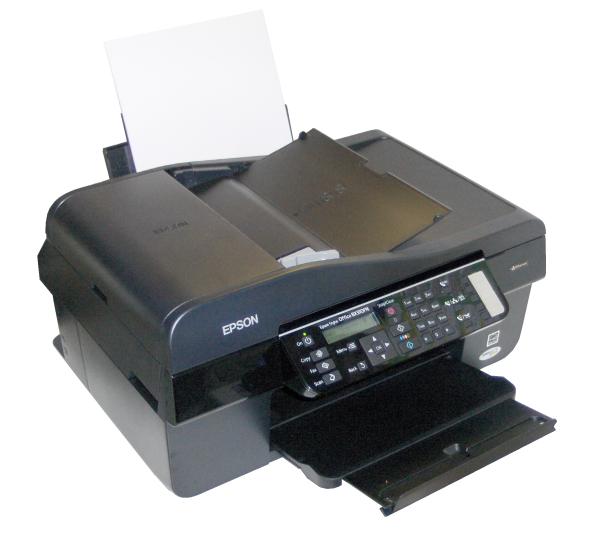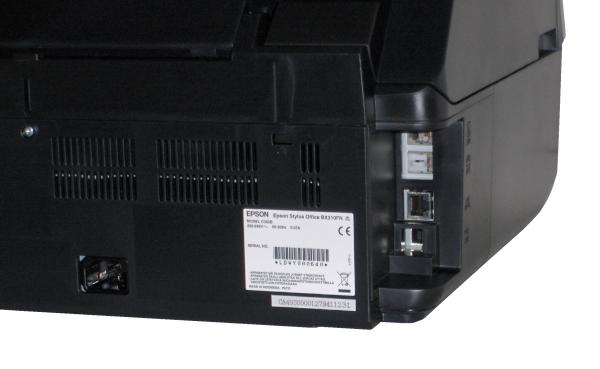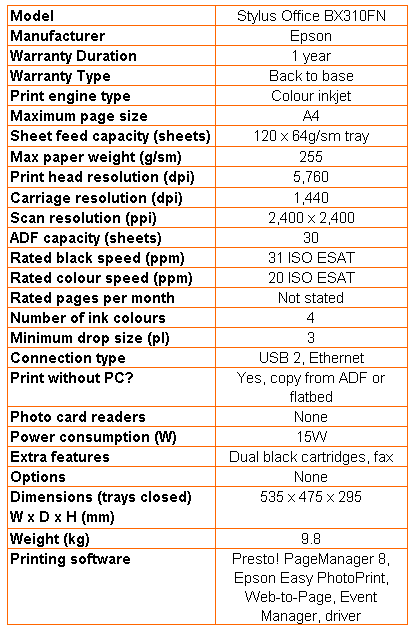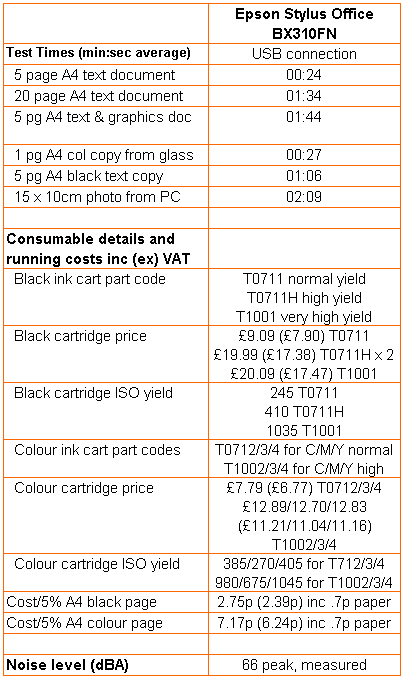Epson Stylus Office BX310FN – Inkjet All-in-One Review
Epson Stylus Office BX310FN – Inkjet All-in-One
We see if Epson's office inkjets can follow in the footsteps of its excellent consumer offerings.

Verdict
Key Specifications
- Review Price: £120.47
In the same way Lexmark has a range of Pro business, inkjet all-in-ones, which have high capacity cartridges, Epson has its Stylus Office machines, which have room in their cartridge carriers for two black cartridges, sitting side-by-side. Today we’re looking at the Stylus Office BX310FN, which is capable of printing over 2,000 pages between cartridge changes.
This is a good-looking and quite sleek machine, with a flip-open Automatic Document Feeder (ADF) tray designed into its low-profile scanner cover. The neat, but quite crowded control panel includes all the essentials, with function buttons down the left-hand side, fax presets down the right-hand side and a number pad, copy buttons and a square of navigation controls in the middle, in front of a 2-line by 16-character mono LCD display, without a backlight.
There are no memory card slots and not even a USB slot for direct print of files from a USB drive. It’s increasingly handy to be able to print directly from this type of storage, particularly in an office machine.
Paper feeds from a fold-out and pull-up tray at the rear to a telescopic tray at the front and also at the back are sockets for USB, Ethernet, fax and an extension handset. There’s no Wi-Fi option on this machine and very little else extra you can add to it.
Epson provides a full version of Presto! PageManager 8 for document handling and OCR, as well as a suite of the standard Epson applications for its all-in-ones. Lift the scanner section and you can plug-in the five, separate ink cartridges the machine can take.
The two black ink cartridge slots are identical and are not text black and photo black, as with some other all-in-ones. Three different black ink cartridges can be used, with standard, high and very high yields. Colour cartridges are available in low and very high yields only.
Since the Stylus Office BX310FN takes the same ink set as the Stylus SX515 we tested last week, you might think it uses exactly the same print engine. It doesn’t though, partly because of its facility to load two black ink cartridges at the same time. Epson quotes a black print speed of 31ppm, with 20ppm for colour.
These are both for the Estimated SATurated Throughput (ESAT) cycle of the ISO speed test, which measures the time it takes to print, but doesn’t include processing or preparation time. We measure print time and hence print speeds from clicking the print button to the last page appearing in the output tray. This will always be longer and slower than an ESAT result, but we continue to be surprised by the differences.
We timed our five-page black text print at 24 seconds, which is equivalent to a speed of 12.5ppm and this only rose to 12.77ppm when we ran the 20-page black text print. When we ran the five-page black text and colour graphics print it took 1:44, which is a speed of just 2.88ppm. A 15 x 10cm photo in best photo mode took 2:09, though in standard mode it took around half this time.
A single page colour copy from the flatbed glass completed in 27 seconds, which is reasonable, and a five-page, black text copy from the ADF ran out at 1:06, which is also a fair speed.
Text print quality isn’t as good as from Canon, HP or Kodak inkjets, as character shapes are jagged and there are definite signs of ink feathering, where the liquid ink has flowed along the paper fibres. Colour output is cleaner, with vivid colours and little sign of banding. Registration of black text over colour is good.
Photo print is clean and sharp, with good, natural colours and plenty of foreground detail. Reproduction of darker shades in shadow isn’t wonderful, though. Copy quality is comparatively poor, with obvious dither patterns in graphics and text looking very jagged.
The noise level from this machine is high, even for an Epson inkjet. We measured peaks of 66dBA at 0.5m, while the machine was feeding paper during printing, but the scanner makes noise at a higher frequency during copying, on top of the print feed, so is even more intrusive. It’s about time Epson did some work on the noise levels of its inkjet machines, which are higher than from any of its main competitors.
The same problem with inks exists with this machine as with the Stylus SX515, namely that cost per page is a lot lower using the T1001/2/3/4 cartridge set than the recommended T701/2/3/4 set. In fact, if you use two T1001 black cartridges, you should get 2,070 pages before you need to change them. This is well into the yield range of mono laser printers and is pretty good for any kind of small office printer.
The cost per page works out at 2.75p for ISO black and 7.17p for ISO colour, both figures including 0.7p for paper. This is very good for this class of inkjet all-in-one and it’s beyond us why Epson doesn’t make more of the low cost. It’s aiming the machine at small business, so surely the low running costs achievable with the T1001/2/3/4 cartridges are an attractive bonus and not something you’d want to keep quiet about.
Verdict
Surprisingly, results from our performance tests of the Stylus Office BX310FN aren’t as good as from the Stylus SX515W, with which we were impressed. Although this machine has the advantage of an ADF and an extra black cartridge slot, in all other respects the photo machine is the better buy.


Trusted Score
Score in detail
-
Print Speed 7
-
Features 7
-
Value 8
-
Print Quality 6
Features
| Networking | Fast Ethernet |
Printing
| Paper Size | A4, A5, A6, B5, Letter, Legal, Envelope No. 10, DL Envelope, C6 Envelope, Custom Size, 130 mm x 200 mm, 130 mm x 180 mm, 200 mm x 250 mm, 100 mm x 150 mm, 90 mm x 130 mm |
| Sheet Capacity | 120 sheets |
| Rated Black Speed (Images per minute) | 31 ppmipm |
| Rated Colour Speed (Images per minute) | 20 ppmipm |
Scanning
| Scan Resolution (Dots per inch) | 1200 x 2400dpi |

